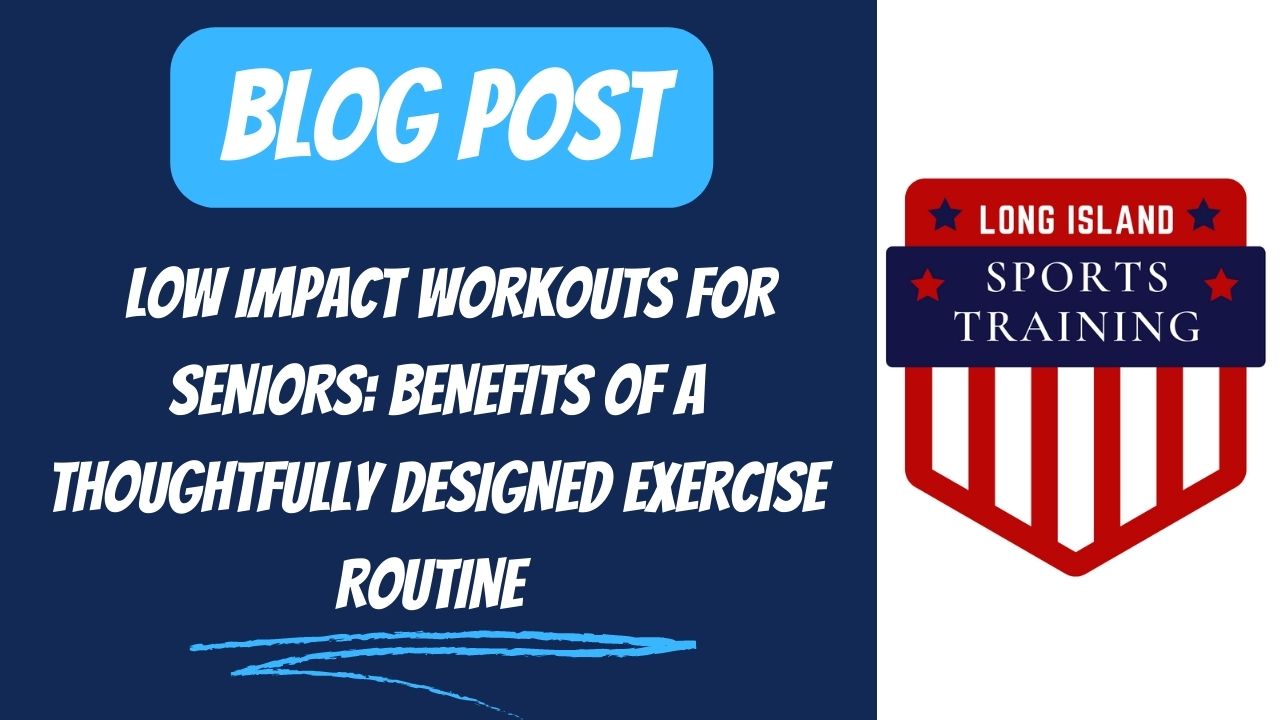Low Impact Workouts For Seniors: Benefits Of A Thoughtfully Designed Exercise Routine
 Low Impact Workouts For Seniors: Benefits Of A Thoughtfully Designed Exercise Routine
Low Impact Workouts For Seniors: Benefits Of A Thoughtfully Designed Exercise Routine
In the post, we delve into the world of low impact workouts for seniors and the benefits of a thoughtfully designed exercise routine for people over 55.
As we gracefully age, our bodies require a different approach to fitness. The concept of “no pain, no gain” may have its place, but for seniors, a thoughtful and low impact exercise routine can deliver remarkable benefits.
Therefore, we will explore the numerous advantages of a carefully crafted low impact workout regimen. From preserving joint health to boosting overall well-being, these exercises offer a pathway to a more active, fulfilling and vibrant life.
The Numerous Benefits Of Low Impact Workouts For Seniors
Low impact workouts for seniors play a pivotal role in promoting healthy aging and enhancing overall quality of life. These tailored exercise routines offer numerous benefits that contribute to physical, mental, and emotional well-being, allowing seniors to enjoy their golden years to the fullest.
Here’s how low impact workouts support healthy aging and an improved quality of life:
- Maintains Joint Health: Low impact exercises reduce stress on joints, helping to preserve joint health and mobility. This minimizes discomfort, inflammation, and the risk of conditions like arthritis, enabling seniors to move more freely and independently.
- Strengthens Muscles and Bones: Engaging in regular low impact workouts builds muscle strength and bone density. Strengthened muscles enhance stability and support, while denser bones reduce the risk of fractures and osteoporosis, ensuring seniors maintain their physical prowess.
- Enhances Cardiovascular Fitness: Low impact cardio exercises, such as walking, swimming, or cycling, improve heart health without straining the body. A healthy cardiovascular system increases energy levels, supports cognitive function, and reduces the risk of heart-related issues.
- Boosts Mood and Mental Well-Being: Exercise triggers the release of endorphins, which are natural mood elevators. Seniors who participate in low impact workouts experience reduced stress, anxiety, and depression, contributing to a positive outlook and enhanced mental well-being.
- Promotes Weight Management: Maintaining a healthy weight becomes increasingly important as we age. Low impact exercises help manage weight by burning calories and promoting a balanced metabolism, reducing the risk of obesity-related health concerns.
- Improves Balance and Coordination: Low impact routines often include balance-enhancing activities, reducing the risk of falls. Improved balance and coordination lead to greater confidence and independence in daily activities.
- Supports Brain Health: Regular physical activity, including low impact workouts, has been linked to cognitive benefits. Exercise increases blood flow to the brain, which can help improve memory, attention, and overall cognitive function.
- Enhances Social Interaction: Participating in group low impact classes or activities fosters social connections, reducing feelings of isolation and loneliness. Social interaction contributes to mental and emotional well-being, improving overall quality of life.
- Increases Energy and Vitality: Seniors who engage in low impact exercises often report increased energy levels and a greater sense of vitality. This renewed vigor allows them to actively participate in hobbies, travel, and social engagements.
- Fosters Independence: By maintaining physical strength, flexibility, and balance, seniors can retain their independence for longer. This independence contributes to a higher quality of life and allows them to engage in activities they love.
- Reduces Chronic Health Risks: Regular exercise, even of low impact nature, can help manage chronic conditions such as diabetes, hypertension, and high cholesterol. This leads to better disease management and improved overall health.
- Increases Longevity: A combination of physical fitness, mental well-being, and social engagement can contribute to a longer, more fulfilling life.
Incorporating low impact workouts into a senior’s lifestyle can be transformative, offering a holistic approach to healthy aging.
How Low Impact Workouts For Seniors Increase Energy And Independence

Low impact workouts for seniors play a vital role in increasing energy levels and promoting independence. These exercise routines offer a balanced and sustainable approach to maintaining physical well-being, which in turn contributes to a more active and self-reliant lifestyle.
Here’s how low impact workouts specifically contribute to increased energy and independence for seniors:
- Balanced Hormones: Regular physical activity, even low impact exercises, stimulates the release of endorphins—natural mood lifters. These endorphins contribute to a positive emotional state, increased mental clarity, and improved energy levels.
- Enhanced Metabolism: Low impact workouts help maintain a healthy metabolism, which is essential for converting food into energy. A well-functioning metabolism ensures seniors have the energy needed to perform daily tasks and engage in enjoyable activities.
- Boosted Circulation: Exercise promotes blood circulation, ensuring that oxygen and nutrients are efficiently transported throughout the body. Improved circulation contributes to increased energy and vitality, reducing feelings of sluggishness.
- Better Sleep Patterns: Regular physical activity, including low impact exercises, can improve sleep quality. Seniors who enjoy restful sleep wake up feeling refreshed and energized, ready to take on the day’s activities.
- Enhanced Respiratory Function: Low impact exercises help improve lung capacity and respiratory function. Efficient breathing ensures that the body receives an adequate supply of oxygen, boosting energy levels and reducing feelings of fatigue.
- Increased Confidence: As seniors engage in regular low impact workouts and experience the positive physical changes that come with it, their confidence in their own abilities grows. This newfound self-assurance contributes to a sense of independence and empowerment.
- Functional Fitness: Low impact exercises focus on movements that mimic daily activities, such as bending, reaching, and lifting. By improving functional fitness, seniors are better equipped to handle day-to-day tasks on their own, enhancing their independence.
- Fall Prevention: Many low impact routines include balance and stability exercises that reduce the risk of falls. Fewer falls mean fewer injuries, maintaining seniors’ independence and confidence.
- Engagement in Activities: Increased energy levels from low impact workouts encourage seniors to participate in social, recreational, and leisure activities. Engaging in these activities enhances mental well-being and fosters a sense of independence.
By embracing low impact workouts, seniors can experience a tangible increase in energy levels and a heightened sense of independence. These exercises provide a sustainable and empowering approach to maintaining physical health, contributing to an overall improved quality of life.
How Low Impact Workouts For Seniors Strengthen Muscles and Bones Safely
Low impact workouts for seniors offer a safe and effective way to strengthen muscles and bones, helping to maintain physical vitality and reduce the risk of age-related conditions.
By incorporating specially designed exercises, seniors can experience improved strength, stability and overall well-being without subjecting their bodies to excessive strain or impact.
Here’s how low impact workouts for seniors achieve these benefits.
- Resistance Training without Stress: Low impact exercises often involve resistance training using body weight, resistance bands, or light weights. These activities place controlled stress on muscles and bones, stimulating them to become stronger without causing undue pressure or risk of injury.
- Preserving Bone Density: Weight-bearing low impact exercises, such as walking, dancing, or gentle aerobics, help maintain bone density. The controlled impact encourages bone remodeling, strengthening the skeletal structure and reducing the likelihood of osteoporosis.
- Enhancing Muscle Mass: Engaging in low impact resistance exercises encourages muscle growth and maintenance. These exercises create tension on muscles, triggering them to adapt and become more robust, aiding in maintaining functional strength.
- Joint-Friendly Movements: Low impact workouts incorporate movements that are kinder to joints. Activities like swimming, stationary cycling, and tai chi reduce joint stress, making it easier for seniors to engage in regular exercise without exacerbating joint pain or discomfort.
- Balancing Act: Many low impact routines include balance-enhancing exercises. These activities challenge stabilizing muscles, which play a crucial role in preventing falls and improving overall stability.
- Gradual Progression: The controlled nature of low impact workouts allows seniors to progress at a pace that suits their individual needs. Over time, exercises can be modified or intensified to continue building strength and resilience.
- Whole-Body Approach: Low impact routines often target multiple muscle groups simultaneously. This holistic approach promotes overall functional fitness, helping seniors maintain a higher level of independence and mobility.
- Personalized Approach: Tailoring low impact workouts to individual fitness levels and goals ensures that seniors can safely engage in activities that best suit their needs, whether they are starting from scratch or looking to maintain their current fitness level.
Scientific Study Of The Positive Outcomes Of Low Impact Workouts For Seniors
Title: “Effects of Low-Impact, Moderate-Intensity Exercise Training with and without Water-Based Exercises on Functional Fitness and Well-Being of Healthy Older Adults”
Authors: Maura Healey, Andrea Summers, et al.
Published in: The Journals of Gerontology: Series A, Volume 60, Issue 4, April 2005, Pages 482–487.
Abstract: This study examined the effects of a 12-week low-impact, moderate-intensity exercise program on the functional fitness and well-being of healthy older adults. The program incorporated both land-based and water-based exercises. Results showed significant improvements in various measures of functional fitness, including aerobic endurance, lower body strength, flexibility, and balance. Participants also reported improved psychological well-being and enhanced quality of life.
You may need to access the study through your institution’s library or other appropriate sources.
Conclusion
Incorporating a thoughtfully designed low impact exercise routine into a senior’s lifestyle can be a life changing experience. From joint-friendly movements to enhanced mental well-being, the benefits are numerous and far-reaching.
By prioritizing senior fitness and embracing the concept of a gentler approach to exercise, individuals can age with grace, strength and vitality. Remember, it’s never too late to start reaping the rewards of a well-crafted low impact workout routine.
Let’s Talk: Contact Tim @ Long Island Sports Training
If you are looking for low impact fitness training sessions contact us:
Website:
https://longislandsportstraining.com/personaltraining/
Phone:
631-594-4048
Email:
Tim@LongIslandSportsTraining.Com
